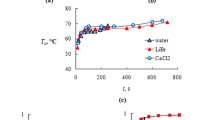Abstract
The distribution of the number of particles in a fluid drop and in the vapor-gas layer adjoining the drop is simulated by the distribution of catastrophe, generation, and immigration known from the theory of random processes. An expression is obtained for the evaporation rate and an explicit analytic dependence for the evaporation coefficient.
Similar content being viewed by others
Literature cited
D. Hirs and G. Pound, Evaporation and Condensation [Russian translation], Metallurgiya, Moscow (1966).
N. A. Fuks, Evaporation and Growth of Drops in a Gaseous Medium [in Russian], Izd. Akad. Nauk SSSR, Moscow (1958).
V. M. Nuzhnyi and V. V. Ryazanov, in: Physics of the Liquid State [in Russian], No. 2, Kiev State Univ. Press, Kiev (1974), p. 74.
A. T. Barucha-Reed, Elements of the Theory of Markov Processes and Their Application [Russian translation], Nauka, Moscow (1969).
Author information
Authors and Affiliations
Additional information
Translated from Izvestiya Vysshikh Uchebnykh Zavedenii, Fizika, No. 11, pp. 109–112, November, 1978.
The authors are grateful to A. V. Chalom for useful discussions of the results.
Rights and permissions
About this article
Cite this article
Ryazanov, V.V., Nuzhnyi, V.M. Evaporation coefficient of a spherical fluid drop. Soviet Physics Journal 21, 1476–1478 (1978). https://doi.org/10.1007/BF00890359
Received:
Revised:
Issue Date:
DOI: https://doi.org/10.1007/BF00890359



